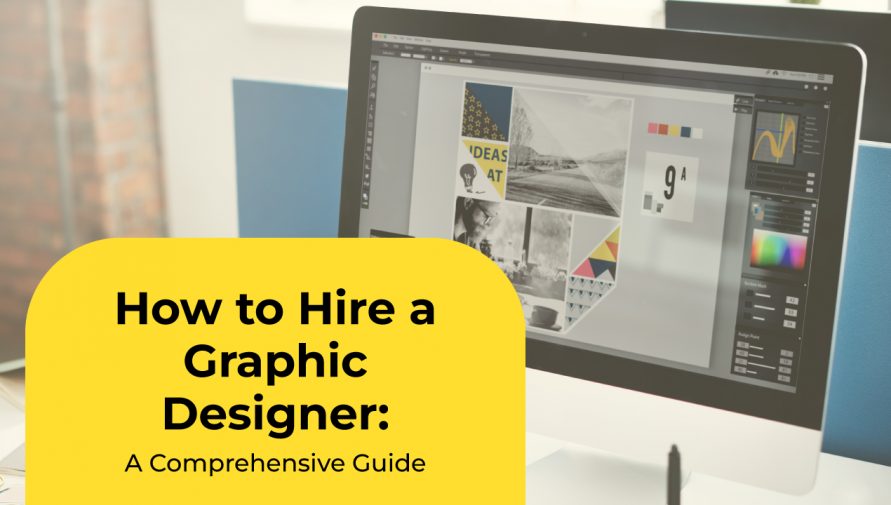How to Hire a Graphic Designer: A Comprehensive Guide
- Shachi Dixit
- July 12, 2024
- 4 Minute Read

As a business entrepreneur, you must know the value of having an effective visual brand identity. A flawless, expertly designed website, advertising collateral, and a logo have the potential to make your company stand out in a highly saturated market and draw in new clients.
50.5% of marketers believe that visual content is crucial, while 80% of small firms agree that the design of their advertising and promotional assets is significant. Hence, you need to hire a graphic designer to curate engaging visual assets that align with your brand values.
However, hiring top talents in graphic design requires a thorough plan of action. From reviewing portfolios to considering budget and project scope, this blog outlines a well-researched roadblock on how to hire a graphic designer. Read on to find more!
How to Hire a Graphic Designer?
Follow these essential steps to ensure you hire the right graphic designer for your needs:
1. Identify Your Design Requirements
Before you set out on the journey of hiring a suitable graphic designer, it is pertinent to understand your design needs and what graphic designers do. Consider the following for seamless collaboration:
- Define the purpose of your project and identify a target audience
- Consider what message you want to convey and the desired outcome of the design
- Conduct market research to understand current design trends and competitor strategies
- Describe the project’s scope by identifying its deliverables, budget, and schedule
- Establish a clear description of the project’s objectives, including the quantity of deliverables, the file formats, and any methods for revisions or comments
- Create a timeline with deadlines and milestones for timely completion
2. Find Potential Candidates
There are a few options to consider while searching for graphic designers: in-house designers, remote designers, and freelancers. Platforms such as Upwork and Fiverr offer freelancers for hire; you can search through their portfolios and evaluations to locate someone who fits the bill for your project.
Remote designers have the advantage of working from any location, which is advantageous for companies with a worldwide clientele. Conversely, in-house designers operate directly within your business, facilitating improved teamwork and communication.
While remote designers provide a blend of quality and flexibility, freelancers could be more economical for short-term assignments. For lengthy projects that require tight coordination and unified branding, in-house designers are the best option.
3. Evaluate Skills and Expertise

When reviewing portfolios to hire graphic designers, several key factors must be considered to assess their mastery of design tools and technical proficiency.
- Look for various projects in their portfolio that showcase different design styles, techniques, and mediums. This will provide you with a clear assessment of their versatility and creativity.
- Evaluate key essentials of their work, including the use of color, typography, layout, and overall aesthetic appeal. Look for attention to detail and consistency in their designs.
- Assess their ability to effectively communicate a message or tell a story through their work
- Look for specific software competencies, such as mastery of the Adobe Creative Suite (Photoshop, Illustrator, InDesign), Sketch, or other pertinent tools, indicated in their portfolio. Take into account the intricacy of the projects they have worked on and how they have used these technologies to accomplish their design objectives.
- To learn more about their technical competence, work ethic, and communication abilities, consider getting in touch with referrals or past clients.
4. Assess Cultural Fit and Compatibility
Assessing a candidate’s work style and cultural fit during the interview is critical for a productive working relationship.
Examine candidates whose values coincide with yours to determine cultural fit. Consider your company’s beliefs, mission, and work environment. Ask them about their past work experiences and teamwork philosophy.
To evaluate work style, inquire about their creative process, time management skills, and ability to meet deadlines. Since graphic design is a creative process, you need to ascertain the candidate takes feedback and criticism constructively. Look for graphic designers who demonstrate a willingness to learn and grow.
Furthermore, you can assign the applicants a design project or run a practical exercise during the interview process. This will help you gauge their design methodology, capacity for problem-solving, and inventiveness.
5. Negotiate Terms and Conditions

Before finalizing the hiring process, ensure all terms and conditions are clearly defined and agreed upon. Discuss the compensation structure, whether it’s hourly rates, project-based fees, or salary for in-house designers.
Clarify payment schedules and any additional expenses. Also, outline ownership rights to the designs created during the project. Specify whether the designer retains rights to use the work in their portfolio.
Additionally, make sure you agree on revisions and approval processes to avoid misunderstandings and ensure alignment throughout the project.
By negotiating these terms upfront, you establish a clear framework for the collaboration and minimize potential conflicts down the road.
6. Streamline Onboarding and Integration
Ensuring a smooth onboarding and integration process for graphic designers paves the way for success within your team.
Here are a few key aspects you need to keep in mind:
- Provide a detailed onboarding plan that outlines the company’s values and goals, as well as specific project requirements and timelines. This will help the designer understand their role within the team and what is expected of them.
- Assign a point of contact for the designer with any queries or issues to create an atmosphere of open communication. Additionally, you can set up frequent check-ins and feedback meetings to address any difficulties early on.
- Establish precise guidelines for deliverables, quality standards, and project deadlines
- Provide the graphic designer access to the tools and resources they need to do their job well, including brand guidelines, design briefs, and design tools.
- Offer a welcoming and inclusive atmosphere where designers are encouraged to express their ideas and talents.
Key Takeaway
Before hiring a graphic designer, thoroughly examine their portfolio to assess their proficiency with design tools, technical skills, and versatility.
Looking ahead, trends in graphic design hiring will emphasize backgrounds in motion graphics, interactive design, and expertise in the user interface (UI) and user experience (UX).
Additionally, the influence of collaborative tools and remote work is reshaping graphic designers’ operations. To attract skilled design talent effectively, businesses must adapt their hiring practices to align with these evolving trends.
In your job postings, highlight the importance of adaptability and willingness to learn new tools and trends. This can attract candidates who are proactive about staying current in the field.

Thank you for submitting the details!
We will keep your information safe. Feel free to contact us with any questions at hello@uplers.com
Please check your email for next steps shared by Robert.

















